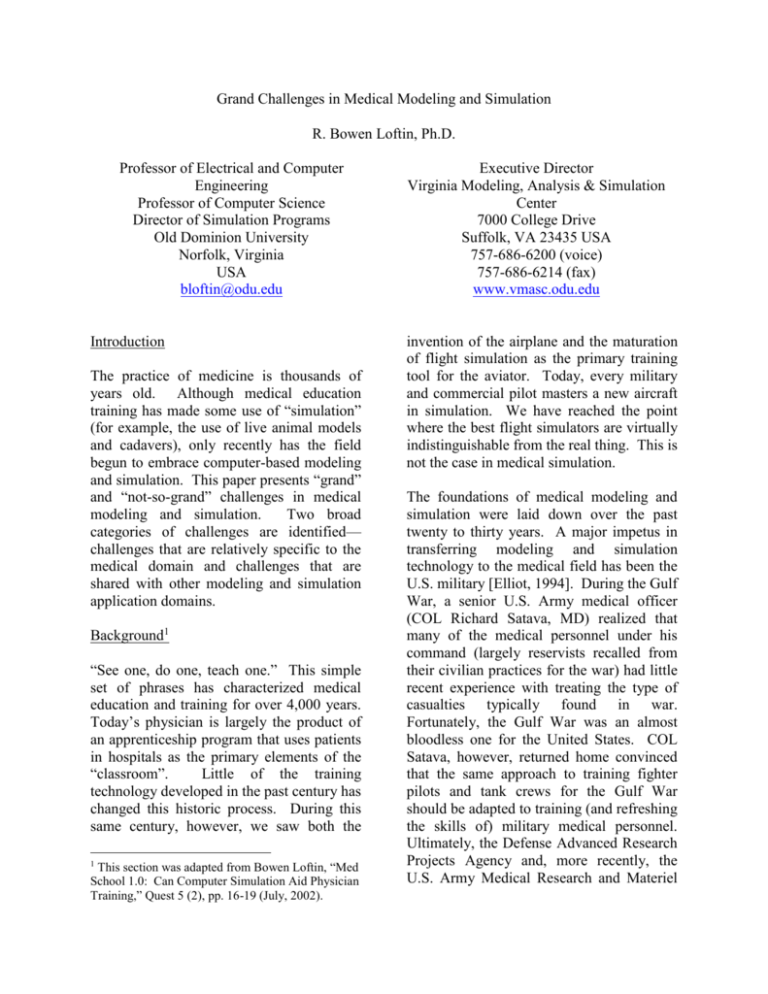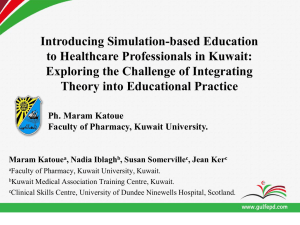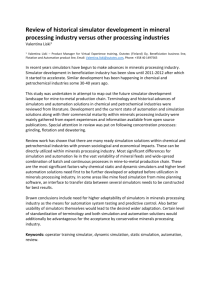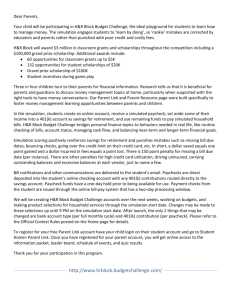Grand Challenges in Medical Modeling and Simulation
advertisement

Grand Challenges in Medical Modeling and Simulation R. Bowen Loftin, Ph.D. Professor of Electrical and Computer Engineering Professor of Computer Science Director of Simulation Programs Old Dominion University Norfolk, Virginia USA bloftin@odu.edu Introduction The practice of medicine is thousands of years old. Although medical education training has made some use of “simulation” (for example, the use of live animal models and cadavers), only recently has the field begun to embrace computer-based modeling and simulation. This paper presents “grand” and “not-so-grand” challenges in medical modeling and simulation. Two broad categories of challenges are identified— challenges that are relatively specific to the medical domain and challenges that are shared with other modeling and simulation application domains. Background1 “See one, do one, teach one.” This simple set of phrases has characterized medical education and training for over 4,000 years. Today’s physician is largely the product of an apprenticeship program that uses patients in hospitals as the primary elements of the “classroom”. Little of the training technology developed in the past century has changed this historic process. During this same century, however, we saw both the This section was adapted from Bowen Loftin, “Med School 1.0: Can Computer Simulation Aid Physician Training,” Quest 5 (2), pp. 16-19 (July, 2002). 1 Executive Director Virginia Modeling, Analysis & Simulation Center 7000 College Drive Suffolk, VA 23435 USA 757-686-6200 (voice) 757-686-6214 (fax) www.vmasc.odu.edu invention of the airplane and the maturation of flight simulation as the primary training tool for the aviator. Today, every military and commercial pilot masters a new aircraft in simulation. We have reached the point where the best flight simulators are virtually indistinguishable from the real thing. This is not the case in medical simulation. The foundations of medical modeling and simulation were laid down over the past twenty to thirty years. A major impetus in transferring modeling and simulation technology to the medical field has been the U.S. military [Elliot, 1994]. During the Gulf War, a senior U.S. Army medical officer (COL Richard Satava, MD) realized that many of the medical personnel under his command (largely reservists recalled from their civilian practices for the war) had little recent experience with treating the type of casualties typically found in war. Fortunately, the Gulf War was an almost bloodless one for the United States. COL Satava, however, returned home convinced that the same approach to training fighter pilots and tank crews for the Gulf War should be adapted to training (and refreshing the skills of) military medical personnel. Ultimately, the Defense Advanced Research Projects Agency and, more recently, the U.S. Army Medical Research and Materiel Command [Moses, 2001] have developed programs to create the needed technologies. The Challenges2 At the outset it is important to note that some of the challenges in medical modeling and simulation are grand and some are not so grand [Ota, 1995]. In addition, some of the challenges described below are identical to or reasonably represented by challenges in other application domains. Below we describe those “unique” and “grand” challenges in some detail and mention other challenges that have common elements with those that are already well known. Tissue Modeling This author’s candidate for the “grandest” challenge in medical modeling and simulation is that of modeling human tissues. The human body is composed of many different tissue types and most medical procedures involve interactions with a number of different tissues. Moreover, each tissue type is typically heterogeneous and likely exhibits highly non-linear and anisotropic behaviors. Finally, a successful model or models must be computable in real-time so that its responses to user inputs are immediately available. [Chen, 2000] Consider a simple incision. The scalpel must pass through the skin (which itself is comprised of several tissue types), through adipose tissue, through muscle tissue (which is highly anisotropic), and, perhaps, into or through an organ. In the process the scalpel will sever blood vessels, releasing blood (yet another type of tissue). In a matter of a few seconds, then, the scalpel may pass through 2 One portion of this section has been adapted from R. Bowen Loftin and Mark Phillips, “’Smart’ Simulations for Medical Training and Planning”. In Proceedings of the 2001 Western Multiconference. more than ten tissue types of tissue, and, in each case, the tissue response (visual, haptic, olfactory, . . .) must be both appropriate to the training objectives and occur with no discernable (to the user) delay. Physics-based approaches to tissue modeling can produce realistic behaviors but are unable to achieve the required real-time performance. The gap between actual and desired performance is so great that even Moore’s Law will not, in the foreseeable future, provide a solution. At present, we have abandoned the effort to generate complete physics-based models and, instead, are tackling the problem by developing firstorder physics models that are “hybridized” with mathematical models, based on empirical data [Fung, 1993] and validated through expert evaluation. Thus, these models can be both computationally tractable and “good enough” in the judgment of experts. Even though this method can provide a solution for some tissue types, we have not been able to address the large number of tissue types that may be simultaneously or successively involved in common medical procedures. Multi-Modal Simulation Another area of great challenge lies in the need for medical simulators to be truly mutli-modal. While it is certainly true that many simulators employ non-visual sensory displays (notably auditory and vestibular) to augment their visual displays, useful medical simulators may require visual, auditory, haptic, and olfactory displays. Assuming that the relevant display technologies actually exist and provide adequate fidelity, the challenge here lies in the correlation of the different displays so that the user perceives sensory cues in proper relation to each other and to user interactions. This problem is exacerbated by the inherent variable (due primarily to distance and ambient air movement) delay in delivering an olfactory stimulus to the user and the bandwidth limitations of current haptic displays. Transfer of Environment Training to the Clinical This challenge of medical modeling and simulation has been met in many other domains. Why should it be regarded as a grand challenge here? The answer lies in the culture of medicine. In spite of many efforts, few studies have examined the degree to which simulator training transfers to the clinical environment. Not only is this difficult because of the typically subjective nature of the evaluation of clinical performance but it is also difficult because the medical community is often resistant to such evaluations. The reasons for this resistance may be manifold. For example, the innate conservatism of medicine brings an imputed risk to new approaches to training. Thus, the supervising physician may be reluctant to allow a student (or a resident or a fellow . . .) to perform a procedure if his or her training has been carried out solely via a simulator. This raises a “catch-22” barrier in that physicians may demand objective evidence of a simulator’s efficacy as a prerequisite to the simulator’s evaluation in a clinical setting. Seamless Integration of the Virtual and Real Medical schools are increasingly utilizing “standardized patients” to train their students in clinical skills. These “patients” are actors/actresses trained to present the symptoms of a variety of diseases. Typically, the student is limited to a patient interview and does not physically examine the “patient” since they do not actually have the disease. For example, a “patient” can be trained to provide a history and describe the symptoms of coronary artery disease. However, the student cannot perform an examination or administer tests that would support a diagnosis since the patient does not actually have the disease. The value of this use of human “simulators” would be greatly enhanced if the student could seamlessly transition from a “real” human that can be interviewed to a “virtual” human (with an instantiation of the anatomical and physiological indicators of a disease). This can only be accomplished if one can rapidly (and cheaply) generate a virtual copy of a real person and “edit” that copy so that it contains the proper anatomical and physiological clues. [Kakadiaris, 1998] Potential of Simulation as a Means of Examining the Practitioner The final challenge that is relatively unique to medical modeling and simulation lies in the potential of the simulator to be used as an evaluator of competence on the part of current practitioners. In general, once a physician is licensed, there is no requirement for periodically demonstrating a given level of continuing competence in a procedure. Simulators can provide a convenient and objective means of regularly confirming a physician’s ability to perform a given procedure at or above an agreed upon level of competence. This is particularly useful for infrequently performed procedures and for physicians who have reached a certain age or who have experienced medical problems that could impair their performance. “Common” Challenges In this section we briefly note challenges in medical modeling and simulation that are (more or less) the same as those found in other modeling and simulation application domains. Fidelity always rears its ugly head. As do many other modeling and simulation user communities, the medical community wants all the fidelity it can get. This “requirement” is offered without supporting data. While it is very likely that the training of some (many, most, . . . ) medical procedures demands the highest available fidelity, at least some, especially basic, skills, should be trainable with more modest levels of fidelity. This is a topic as worthy of research as it is in other application domains. Human-Simulator Interfaces are often, as in other domains, critical. In order to avoid negative training and to provide a “complete” training solution, a medical simulator designed to train a procedure, as opposed to a basic skill, should have an interface that replicates that of the real world. Thus, the student should touch instruments that provide the same look and feel as their real world counterparts. If other devices are used (for example, an endoscopic camera), they should also be replicated in the simulator. This requirement can be challenging, especially if the simulator addresses open surgery where the degrees of freedom and the numbers of instruments are significantly larger than in minimally-invasive surgery. [Baur, 1998] In order to provide a spectrum of simulators that spans the medical education and training continuum, attention must also be given to Interoperability. Unfortunately, most medical simulators have been developed independently with little or no thought given to their integration into a family of simulators designed to train a complete procedure (for example, a dissection simulator coupled to one for suturing). Thus, as in other application domains, there is a need for standardization that supports interoperability and integration. Another element of integration involves the Medical Curriculum. This curriculum was developed before simulators were available and does not explicitly include them. Thought, therefore, must be given to revising the medical curriculum to properly exploit simulation. Embedding Intelligence in simulators is not a new idea. Clearly, given the value of medical expertise and the demands of the clinical environment on this expertise, there is great value in embedding an expert “coach” into many simulators. Such embedded coaches would allow students to benefit from simulator-based training without the need for an expert to be present as a guide, mentor, and evaluator. Data Representation is a particularly acute issue for medical modeling and simulation, as it is for other application areas. Raw data is often volumetric in nature (from CAT or MRI sources) but can also be photographic. Models derived from this data have historically been polygonal surfaces so that rendering performance is maximized. More recently, true volumetric data sets have become popular [Bro-Nielsen, 1999]. Composability of medical models and simulations poses a significant barrier to the wider use of the technology for education and training as well as for procedure planning. So long as each model or simulation is “hand crafted”, cost (see the next paragraph) and development time will continue to be problems. Cost, of course, is a major issue for medical modeling and simulation. Although the popular perception may be that the medical enterprise is well funded, the reality, especially in medical education, is quite the opposite. The cost of simulators must be significantly reduced if they are to become commonly-available tools within the medical school curriculum. [Cotin, 1998] Cotin, S., Delingette, H., and Ayache, N. “Real-Time Elastic Deformations of Soft Tissues for Surgery Simulation.” Technical Report 3511, INRIA, October, 1998. Conclusions [Delingette, 1998] Delingette, H. “Towards Realistic Soft Tissue Modeling in Medical Simulation.” Technical Report 3506, INRIA, 1998. In this position paper we have identified five grand (or not-so-grand) challenges in the field of medical modeling and simulation. Chief among these is the problem of tissue modeling. In addition, a number of other challenges have been noted that are shared, to a greater or lesser degree, with other applications of medical modeling and simulation. The medical domain clearly provides a rich set of problems the solution to which are of high value to both the military and civilian sectors. [Elliot, 1994] Elliot D, Combat Casualty Care: Current Capabilities and Inadequacies – A Surgeon’s Perspective. In Proceedings of the Advanced Technology Applications to Combat Casualty Care Workshop, pp. 1314, May 25-26, 1994, pp. 13-14. [Fung, 1993] Fung, Y.C. Biomechanics: Mechanical Properties of Living Tissues. New York: Springer-Verlag, 1993. References [Baur, 1998] Baur, C., Guzzoni, D, and Georg, O. “VIRGY: A Virtual Reality and Force Feedback-Based Endoscopic Surgery Simulator. In Proceedings of Medicine Meets Virtual Realty 6, San Diego, CA, January 28-31, 1998. IOS Press. [Bro-Nielsen, 1999] Bro-Nielseen, M. and Cotin, S. “Real-Time Volumetric Deformable Models for Surgery Simulation Using Finite Elements and Condensation.” In Proceedings of Medicine Meets Virtual Realty76, San Francisco, CA, January 2831, 1999. IOS Press. [Chen, 2000] Chen, D., Kakadiaris, I., Miller, M., B. Loftin and Patrick, C. Modeling for plastic and re-constructive breast surgery. In Proceedings of the Medical Robotics, Imaging and Computer Assisted Surgery Conference, Pittsburgh, PA, October 11-14, 2000. [Kakadiaris, 1998] Kakadiaris, I.A. and Metaxas, D. “3D Human Body Model Acquisition from Multiple Views.” International Journal on Computer Vision 30 (3), pp. 191-218 (1998). [Moses, 2001] Moses G, Magee J, H, Bauer J, Leitch R. Military Medical Modeling and simulation in the 21st Century. In Proceedings of Medicine Meets Virtual Reality 2001 Conference, pp. 322-328. [Ota, 1995] Ota, D., Loftin, R.B., Saito, T., Lea, R. and Keller, J. Virtual Reality in Surgical Education. Computers in Biology and Medicine 25 (2), pp. 127-137 (1995).







